Harvard stem cell researchers granted approval
Will attempt creation of disease-specific embryonic stem cell lines
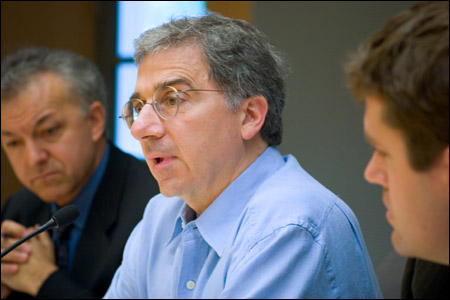
Bios of Harvard stem cell researchers:
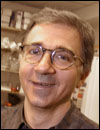 Douglas A. Melton
Douglas A. Melton
(Download photo)
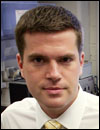 Kevin C. Eggan
Kevin C. Eggan
(Download photo)
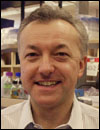 George Q. Daley
George Q. Daley
(Download photo)
Related links:
Contact: B.D. Colen
(617) 495-7821
(617) 413-1224 (cell)
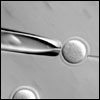 (Download photo) After more than two years of intensive ethical and scientific review, Harvard Stem Cell Institute (HSCI) researchers at Harvard and Children’s Hospital Boston have been cleared to begin experiments using Somatic Cell Nuclear Transfer (SCNT) to create disease-specific stem cell lines in an effort to develop treatments for a wide range of now-incurable conditions afflicting tens of millions of people.
(Download photo) After more than two years of intensive ethical and scientific review, Harvard Stem Cell Institute (HSCI) researchers at Harvard and Children’s Hospital Boston have been cleared to begin experiments using Somatic Cell Nuclear Transfer (SCNT) to create disease-specific stem cell lines in an effort to develop treatments for a wide range of now-incurable conditions afflicting tens of millions of people.
As far as is known, this decision marks the beginning of the first noncommercial effort in the United States to use human embryonic stem cells in a series of experiments whose principle has already been proven in animals. The work is being entirely supported with private funds because of the federal restrictions on human embryonic stem cell work. If successful, it will mark a major step forward in the effort to use stem cells to treat chronic diseases.
The work will be conducted by two groups headed by HSCI senior investigators: Douglas Melton, co-director of the Harvard Stem Cell Institute and Thomas Dudley Cabot Professor of Natural Science in Harvard’s Faculty of Arts and Sciences (FAS), and HSCI principal faculty member Assistant Professor Kevin Eggan, of the FAS Department of Molecular and Cellular Biology; and Harvard Medical School Associate Professor George Daley of Children’s Hospital Boston, who has already begun some of his experiments.
Melton’s work will focus on diabetes; Eggan will initially work with Melton on diabetes, and then plans to focus on neurodegenerative diseases, such as amyotrophic lateral sclerosis (ALS) – better known as Lou Gehrig’s disease. Daley’s group will focus on blood disorders. Daley was one of the principal scientists who in 2002 demonstrated in a mouse model the feasibility of using SCNT to treat immune deficiency.
Harvard University Provost Steven E. Hyman said during a June 6 telephone press conference that the work has been the subject of “more than two years of thoughtful, intensive review by as many as eight different Institutional Review Boards and Stem Cell oversight committees at five different institutions,” including Harvard, Children’s Hospital, Partners Health Care, Brigham and Women’s Hospital, Boston IVF, and Columbia University.
Harvard University President Lawrence H. Summers called the approvals “a seminal event in the University’s effort to advance this tremendously promising area of science and fulfill that promise as quickly as possible for the countless patients suffering from diabetes, Parkinson’s disease, heart disease, cancers, and a host of other illnesses.
“While we understand and respect the sincerely held beliefs of those who oppose this research, we are equally sincere in our belief that the life-and-death medical needs of countless suffering children and adults justifies moving forward with this research,” Summers said, referring to the controversy over embryonic stem cell work.
The Harvard Stem Cell Institute, co-directed by Melton, a Howard Hughes Medical Institute investigator, and David Scadden, a professor of medicine at Harvard Medical School and director of the Center of Regenerative Medicine at Massachusetts General Hospital, is a unique collaborative effort that includes 99 principal investigators and hundreds of additional scientists in laboratories at Harvard University and at many of Harvard’s affiliated hospitals. The institute is dedicated to advancing all forms of stem cell science from laboratory bench to patient bedside as quickly as possible.
Somatic Cell Nuclear Transfer involves removing nuclei, which contain the cellular DNA (genes) from egg cells, and replacing them with the nuclei of donor cells. The resulting cell is subject to a chemical, or electrical, charge that triggers cell division and the creation of an embryo genetically identical to the donor of the nuclei. In the HSCI experiments, aimed at understanding diseases, the nuclei will be taken from skin cells donated by patients suffering from diabetes, blood diseases, and neurodegenerative diseases.
The controversy
Research involving human embryonic stem cells is controversial because extracting the cells – which can differentiate into any cell or tissue type in the body – requires the destruction of a human embryo, albeit a blastocyst of only a few hundred cells, literally half the size of the period at the end of this sentence. Opponents of the work contend that no potential medical benefit can justify the destruction of what they view as a human life, or even as a person.
But Melton responds that “all human cells, even individual sperm and eggs, are ‘living.’ The relevant question is ‘when does personhood begin?’ That’s a valid theological or philosophical question, but from the scientific perspective, this work holds enormous potential to save lives, cure diseases, and improve the health of millions of people. The reality of the suffering of those individuals far outweighs the potential of blastocysts that would never be implanted and allowed to come to term even if we did not do this research,” he said.
Melton, in collaboration with Kevin Eggan and Douglas Powers of Boston IVF , has already created 31 stem cell lines using left-over frozen embryos donated by couples who went through in vitro fertilization (IVF), and has distributed those stem cell lines to scientists around the world.
The work
Embryonic stem cells are the master cells of the body, capable of developing into any tissue type. The researchers will seek to learn how to control that differentiation, with a goal of eventually creating lines of cells that can, for instance, produce insulin-making islet cells in the pancreas, which are depleted or absent in diabetics. Melton and Eggan’s first nuclear transfer experiments will attempt to create diabetes specific stem cells by removing the nuclei from skin cells taken from diabetic volunteers at the Naomi Berrie Diabetes Center at Columbia University Medical Center and inserting them into donor eggs from which the nuclei have been removed.
In addition to collaborating with Melton on this project, Eggan, whose work is supported by the Stowers Medical Institute, is seeking approvals to study diseases of the nervous system.
Children’s Hospital researcher and HSCI Executive Committee member George Daley explains that the ultimate goal of all three HSCI researchers, once they understand how embryonic stem cells are programmed to differentiate into specific cell types, is to literally move a patient’s disease into a petri [laboratory] dish. “We plan to take skin cells from a patient with a genetic disease, like sickle cell anemia or any one of more than 40 bone marrow disorders, and reprogram that skin cell back to its embryonic state. We can then study the disease using these cells, correct their genetic defects and coax the repaired cells to become normal blood cells. Our ultimate goal is to return the repaired cells to the patients.” Such cells, genetically identical to the patients receiving them, would be accepted by the patient’s immune system and wouldn’t require the use of immunosuppressive drugs.
Egg donation and reimbursement
Research using human embryonic stem cells is ineligible for federal funding, including grants from the National Institute of Health; only private money may be used to support SCNT research. Harvard University and Children’s Hospital have business processes and financial controls in place to ensure that no federal money is used in support of this research.
Under the protocol approved by the Institutional Review Board (IRB) of Harvard’s Faculty of Arts and Science, and the IRB of Boston IVF, where the ova will be collected for Melton and Eggan’s work, donors will not be paid. They will, however, be reimbursed for travel and other expenses, such as child care, directly related to the research, and they will be provided with a special insurance policy in case medical care is necessitated by any possible complications associated with the donation procedure.
Couples looking for ova donors in order to become pregnant pay – and often pay large sums – for ova; the HSCI researchers and IRBs decided against compensating donors to avoid even the suggestion of inducement that payment might raise.
While that was one important area of focus for the FAS and Boston IVF IRBs and Harvard’s stem cell oversight committee, an even more important issue was making sure that donor consent was truly informed. The committees struggled to ensure not only that potential donors would understand all potential risks associated with ova donation, but would also understand that they will be contributing to basic science experiments, and that it will be many years – at best – before patients benefit directly from the work.
Speaking of the IRB decisions at Harvard, Children’s Hospital, Boston IVF, Brigham and Women’s Hospital – where Daley is obtaining ova for his experiments – and Columbia University allowing the Harvard Stem Cell Institute SCNT work to proceed, Melton says, “I think Harvard University has done the right thing by giving this research very careful review by multiple boards, and allowing plenty of time for reconsideration and reflection. If this new technology is to realize its promise, scientists should have the support of the community and proceed deliberately and carefully.”




